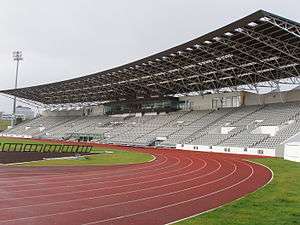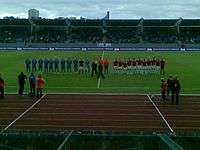Laugardalsvöllur
 | |
| Location |
Laugardalur IS-104 Reykjavík, Iceland |
|---|---|
| Coordinates | 64°08′36.9″N 21°52′44.2″W / 64.143583°N 21.878944°WCoordinates: 64°08′36.9″N 21°52′44.2″W / 64.143583°N 21.878944°W |
| Capacity | 15,000 |
| Construction | |
| Broke ground | 1949 |
| Opened | 17 June 1959 |
| Renovated | 1970, 1997 and 2007 |
| Tenants | |
|
Iceland men's national football team Iceland women's national football team Iceland U21 Iceland U19 Knattspyrnufélagið Fram (temporary) | |
Laugardalsvöllur (Icelandic pronunciation: [ˈløiːɣar.talsˌvœtl̥ʏr̥]) is Iceland's national football stadium and the home venue for the Iceland national football team. It is in Reykjavík and seats 9,800 with a total capacity of 15,000.
History
The idea of building a sport venue in Laugardalur, along with some other entertainment facilities, dates back to 1871. At that time, the population of Reykjavík, the capital of Iceland, was only about 2,000. Laugardalur was also nearly 3 km (1.9 mi) away from residential areas. Little came out of this proposal the next 60 years or so.
In 1943, the town council set up the Laugardalsnefnd committee. Its task was to make proposals and ideas for the area. The committee then delivered the result later, which included building a new football stadium and a new swimming pool.
Construction of the field started in 1949 and lasted until 1952. A year later in 1953, construction of a new stand started. The stand had a capacity of 4,000 when completed.
The first match was played on Laugardalsvöllur in 1957 when the Iceland men's national football team played against Norway, two years before the official opening on 17 June 1959. A few years later, the stand was renovated and expanded, starting from 1965 to 1970.[1]
Under the new stand there was opened a track-and-field facility, which operated until 2007, although there has always been all-weather running track around the pitch (upgraded in 1992). Later the year 1992, floodlights were inaugurated for the match against Greece.
In 1997, another new stand was built against the old stand, across the pitch. Constructions started a year earlier. It has a capacity of 3,500. At the same time, the old stand was relieved by matching it with the new stand by seating capacity.[2]
Big renovation and expansion of the old stand started in 2005. After the completion in 2007, the stadium has a capacity of 9,800. Additional capacity can be added by bringing in two temporary stands seating 1,500 each, giving the stadium a maximum capacity of 15,000 but after the new requirements of FIFA for national football stadiums, this addition method has been forbidden. No major renovations or expansions have occurred since 2007.[3]
The largest attendance for a football match ever seen by Laugardalsvöllur was 20,204 in 2004 in a friendly match between Iceland and Italy. The largest attendance for the venue about 25,000 during a concert in 2007.[4]
On 24 July 2018, American rock band Guns N' Roses played at the stadium in font of 25,000 people, at that time the largest rock concert ever held in Iceland. [5]
Facilities
The stadium comprises two big stands facing each other. West Stand is the main stand and the larger one. It is the only stand to hold all the facilities needed for the stadium, excluding stadium seating. For the purpose of football matches and other competitions, the stand has 4 changing rooms for players (mainly) and 2 others for referees, which also have the capability of accommodating facility for a doctor or drug test. There are two other rooms for football matches and athletics tournaments administration.
Future
There have been plans to renovate and expand Laugardalsvöllur since Iceland men's national football team reached play-off for the 2014 FIFA World Cup in 2013. The team's success kept going until they went to UEFA Euro 2016 and reached quarter-finals. Both Icelandic football fans and KSÍ (the Football Association of Iceland) have been asking for new stadium because seats have sold out for nearly all official matches (even friendly matches) since 2013.
Several ways are available, but all of them have at least two things in common: removing the running track and cover the stadium. KSÍ has stated that it wants a retractable-roof stadium for the possibility of multi-purpose stadium, that would increase the utilization of seating capacity in the long term.
There are stadiums in Europe that can be used as a guide for Iceland. They are all big and extremely expensive on the local scale. The upcoming construction of Laugardalsvöllur is, for instance, expected to cost about 8 billion ISK (about €62 million). If built, the new national football stadium of Iceland is likely to have a capacity of 20,000 or more.
The pitch itself would have to be dug many meters in the ground since the running track is to be removed and the bottom edge of the stadium will be moved closer to the pitch. By doing that, the stadium will have a lot more capacity. The new pitch is expected to be heated if natural grass is selected, due to hard winters in Iceland and also because of the new requirements of UEFA, which indicates that matches for some teams in the qualification competition, for the UEFA European Championship, shall also be played in the winter.[6] The grass would then be maintained itself with an automatic irrigation sprinkler system.
Because the new stadium requires a retractable roof to cover the costs, it is possible that all present structures of Laugardalsvöllur will be demolished and a new, solid, oval-shaped stadium will be built; neither of the existing stands are specially designed to support additional roof that can roll back and forth on tracks, that can open and close the stadium altogether.
Gallery
 Laugardalsvöllur during a Euro 2008 qualifying game
Laugardalsvöllur during a Euro 2008 qualifying game
- The arena seen from the footpath along Reykjavegur
References
- ↑ "Íþróttaleikvangur Reykjavíkur í LaugardalSaga framkvæmdanna" (in Icelandic). 6 November 2012. Retrieved 2016-09-26.
- ↑ "Ártöl í sögu knattspyrnunnar á Íslandi 1892 "Knattleikur er t.d. flestra unglinga yndi og mætti tíðka hann miklu meira en gert". www.mbl.is. Retrieved 2016-09-26.
- ↑ Rúnarsson, Kristján Jens (1 January 2016). "Stækkun Laugardalsvallar : Er skynsamlegt fyrir Reykjavíkurborg að taka þátt í hugsanlegum breytingum?".
- ↑ "Þjóðarleikvangur Íslands | Knattspyrnusamband Íslands". www.ksi.is. Retrieved 2016-09-26.
- ↑ http://icelandmag.is/article/interview-axl-rose-guns-nroses-reykjavik-concert-largest-icelandic-history
- ↑ "Hótel og háskóli á nýjum Laugardalsvelli?". RÚV. 26 September 2016. Retrieved 2016-10-07.
External links
| Wikimedia Commons has media related to Laugardalsvöllur. |